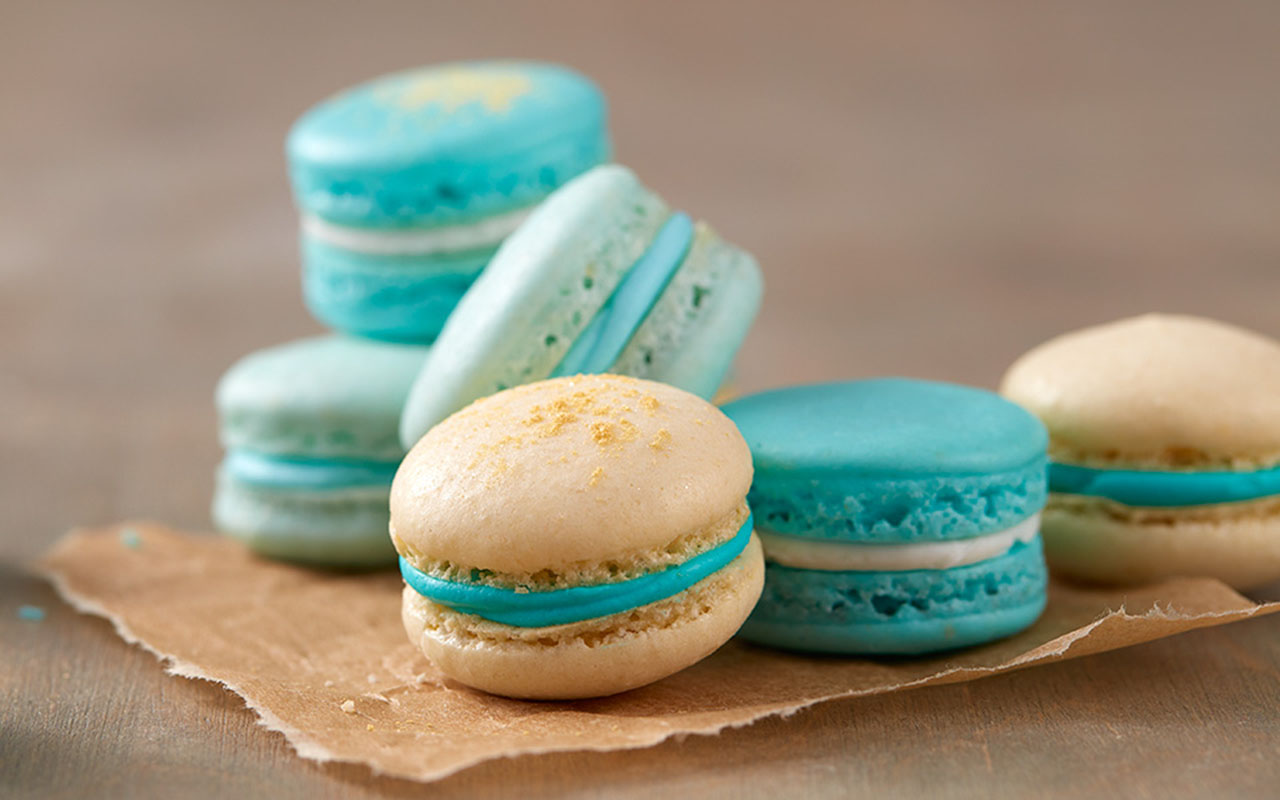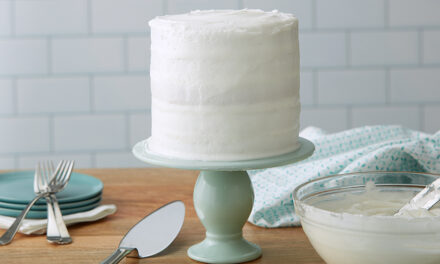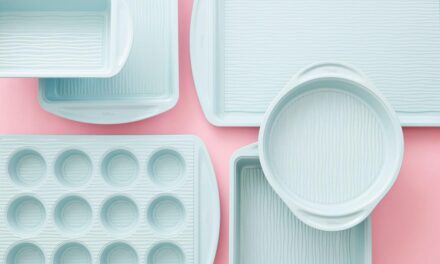Light and delicate, French macarons are an elegant sweet you can make for almost every occasion. However, if you miss a step, there’s a chance your macarons can come out hollow, flat, cracked or burned.
We’ve created a troubleshooting guide out of our most-asked macaron questions to help you make perfect macarons every time.
What is the Difference Between a Macaron and a Macaroon?
To start, let’s make sure we’re all talking about the same thing. A macaron is a French meringue-based cookie sandwich. A macaroon is a coconut-based drop-cookie, often made with sweetened condensed milk.
Why Are My Macarons Hollow?
Hollow shells are often the result of under-whipping or over-whipping your egg whites. To prevent getting hollow shells, make sure your egg whites have reached stiff peaks – nothing more, nothing less. To test for stiff peaks, pull the beaters out of the bowl. If the peaks on the beaters and in the bowl remain upright, you’re good to go!
Why Don’t My Macarons Have Feet?
Macaron feet are the tell-tale sign of a well-baked macaron. These little ruffles around the edge of the shell should be small and unbroken. Big and bubbly feet are often a sign that the insides have been pushed out, causing a hollow macaron.
If your macarons don’t have feet, it could be because your batter is too wet. Make sure you’re using aged egg whites (more on that below) and avoid adding liquid flavoring and coloring.
Most likely the reason for underdeveloped feet is because your macarons did not develop a skin before baking. Besides giving your shells happy feet, the skin helps prevent spreading and gives your shells that coveted shiny dome finish. To help your macarons develop a skin, leave them out at room temperature after piping for 20 to 30 minutes. Carefully touch the tops of your shells. If you feel a skin has developed, they’re ready to bake.
Why Did My Macarons Crack?
A cracked top is most likely due to having too much air in the batter. This can be fixed by rapping the tray against your counter after piping your cookies to remove any air bubbles.
Another reason your cookies may be cracking is because your oven has hot spots. To ensure even baking, put one tray at a time in the oven for best air circulation.
Can I Use Store-Bought Liquid Egg Whites or Meringue Powder Instead of Separating Eggs Myself?
Egg whites in a carton are usually pasteurized, which is not ideal for meringue. The heat from the pasteurization process negatively affects the proteins that are essential for making meringue. Likewise, meringue powder is not strong enough to hold a stiff meringue batter. To get the best macarons, we suggest separating eggs yourself. Trust us, it’s worth it!

What Are Aged Egg Whites?
Aged egg whites are separated at least a day ahead of time to help relax the proteins inside the whites. Doing this helps prevent over-whipping and creates a strong meringue with stiff peaks. Separate your eggs and keep the whites in the fridge in an air-tight container until ready to use. We recommend doing this at least 24 hours in advance of baking.
Can I Use All-Purpose Flour Instead of Almond Flour?
The short answer here is no. All-purpose flours and bread flours are much different than nut flours. If you use an all-purpose flour, chances are your batter will turn out similar to that of angel food cake. Almond flour is made entirely from almonds and has a much higher fat content than wheat flours. While you can’t sub in bread flours here, you can try different nut-based flours if desired.
What is the Proper Way to Fold the Batter?
Folding, also known as macaronage, is probably the most crucial stage in making macarons. We suggest folding your dry ingredients into the wet ingredients in batches. This will help you regulate your folding. Keep in mind that you might need to do between 40 and 60 folds to get the proper consistency.
Test for proper consistency using the figure 8 method. Lift a small amount of batter with your spatula, then drop it back into the bowl in a figure 8 pattern. If the edges soften and the 8 is absorbed back into the batter within 10 seconds, you’re ready to pipe.

How Long Do I Need to Wait Before I Put the Macarons in the Oven?
Usually 20 to 30 minutes at room temperature. All you’re waiting for is for a skin to form on the shell. To test whether your cookies are ready to bake, carefully touch the tops of your cookies. If your finger is dry and you feel a skin has developed, they’re ready to bake.
Can I Add Color or Flavor to My Macaron Batter?
Of course you can add color! However, liquid food color may affect the consistency of this delicate batter, so we suggest using a gel or powdered color additive.
Flavor is a little trickier. Most flavor add-ins are liquid, which will likely thin out your batter. For best results, keep the flavor in the filling (which is the best part anyway).
Why Did My Macarons Spread Quickly Once Piped?
Spreading is often due to thin batter, caused by overmixing or under-whipped egg whites. Your cookie batter should be thick, yet runny enough to fall into a ribbon when you lift the spatula.
Do You Recommend Parchment Paper or a Silicone Baking Mat?
Either one works! Cookies baked on silicone may need to be in the oven a little longer than those baked on parchment paper. The slightly see-through nature of parchment paper makes it the best option for following a template when piping your macarons. Simply place the print-out template under the parchment paper and pipe perfect macarons every time.
How Do I Get Started Making Macarons?
Ready to give these delicate cookies a try? Check out our step-by-step video for helpful techniques, tips and tricks for making your cookies! Learn how to make marbled macaron shells and see the macaronage technique in action!
A Few More Things to Keep in Mind:
- Use a digital scale to help measure ingredients properly
- Sift almond flour and confectioners’ sugar to get rid of lumps
- Make sure all your utensils and bowls are free of oil and dust
- When piping, use a template for even circles. Find our Macaron Template PDF here.
- Large decorating tips like 1A or 2A also help create consistent shells
- For great results, use an oven thermometer to make sure the heat is at the proper setting
- Let your shells cool slightly before removing them from the pan to protect the bottoms
- Macarons taste even better a day or two later! Store them in an air-tight container in the fridge to let the flavors mix and mingle
Do you have any macaron tips and tricks? Share them with us in the comments below!







What does it mean for a macaron to ‘bloom’? I see it all the time in directions, to leave them 24 hours to bloom, but no explanation what that means. Is that just flavors mingling, and a ‘better if you do this’ or something critical?
We piped the filings in the macarons and let them set for a couple days. This lets the cookie absorb some of the moisture from the filling and soften. The purpose of this is to prevent the filling from oozing out of the sides when you bite into the macaron. This is definitely not critical. We know how tempting macarons can be!
Why do Macarons come out chewy?